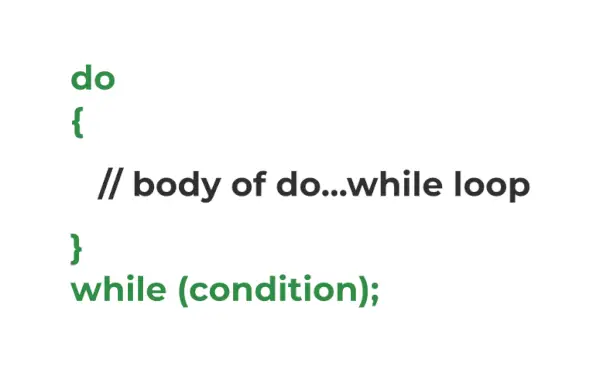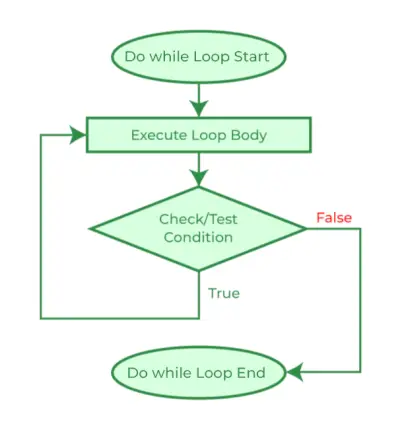Slučky v jazyku C sú príkazy riadiaceho toku, ktoré sa používajú na opakovanie niektorej časti kódu, kým nie je splnená daná podmienka. The slučka do-while je jedným z troch príkazov cyklu v jazyku C, ostatné sú cyklus while a cyklus for. Používa sa hlavne na prechádzanie poľami, vektormi a inými dátovými štruktúrami.
Čo je robiť... kým sa slučka v C?
The robiť...v C je príkaz cyklu používaný na opakovanie niektorej časti kódu, kým nie je splnená daná podmienka. Je to forma an výstupom riadená alebo dodatočne testovaná slučka kde sa testovacia podmienka kontroluje po vykonaní tela slučky. Vďaka tomu sa príkazy v slučke do...while vykonajú vždy aspoň raz, bez ohľadu na to, aká je podmienka.
Syntax do... while Loop v C
do { // body of do-while loop } while ( condition );> Ako používať do...pri slučke v C
Nasledujúci príklad demonštruje použitie slučky do...while v programovacom jazyku C.
C
// C Program to demonstrate the use of do...while loop> #include> int> main()> {> >// loop variable declaration and initialization> >int> i = 0;> >// do while loop> >do> {> >printf>(>'Geeks
'>);> >i++;> >}>while> (i <3);> >return> 0;> }> |
>
>Výkon
Geeks Geeks Geeks>
Ako funguje funkcia...kým Loop funguje?

Syntax Štruktúra cyklu do while
Fungovanie cyklu do...while je vysvetlené nižšie:
- Keď sa ovládanie programu prvýkrát dostane do slučky do...while, najprv sa vykoná telo cyklu a potom sa skontroluje testovacia podmienka/výraz , na rozdiel od iných slučiek, kde sa najskôr kontroluje testovacia podmienka. Vďaka tejto vlastnosti sa slučka do...while nazýva aj slučka riadená ukončením alebo dodatočne testovaná slučka.
- Keď sa testovacia podmienka vyhodnotí ako pravda , ovládanie programu sa spustí cyklu a telo sa vykoná ešte raz.
- Vyššie uvedený proces sa opakuje, kým nie sú splnené podmienky testu.
- Keď sa testovacia podmienka vyhodnotí ako falošné, ovládacie prvky programu prejdú na ďalšie príkazy po slučke do...while.
Rovnako ako v prípade cyklu while v jazyku C, inicializácia a aktualizácia nie je súčasťou syntaxe cyklu do...while. Musíme to urobiť explicitne pred a v slučke.
Vývojový diagram nižšie zobrazuje vizuálnu reprezentáciu toku cyklu do... while v C.
C do...pri slučke vývojového diagramu

Vývojový diagram robte...pri slučke v C
Vnorené do...pri slučke v C
Rovnako ako pri iných slučkách, môžeme tiež vložiť jednu slučku do...while do inej slučky. Je to demonštrované pomocou nasledujúceho programu C.
Príklad funkcie Nested do...while Loop v C:
C
// C Program to demonstrate the nesting of do...while loop> #include> int> main()> {> >// declaring loop variables> >int> i = 0, j;> >int> count = 0;> >// outer loop starts> >do> {> >j = 0;> >// inner loop starts> >do> {> >printf>(>'%d '>, count++);> >j++;> >}>while> (j <3);> >// inner loop ends> >printf>(>'
'>);> >i++;> >}>while> (i <3);> >// outer loop ends> >return> 0;> }> |
>
>Výkon
0 1 2 3 4 5 6 7 8>
Ak sa chcete dozvedieť viac o vnorených slučkách v C, pozrite si tento článok – Vnorené slučky v C s príkladmi
Príklady funkcie do...while Loop v C
Príklad 1. C Program na demonštráciu správania cyklu do...while, ak je podmienka od začiatku nepravdivá.
C
java inicializovať pole
// C Program to demonstrate the do...while loop behaviour> // when the condition is false from the start> #include> #include> int> main()> {> >// declaring a false variable> >bool> condition =>false>;> >do> {> >printf>(>'This is loop body.'>);> >}>while> (condition);>// false condition> >return> 0;> }> |
>
>Výkon
This is loop body.>
Ako vidíme, aj keď je podmienka na začiatku nepravdivá, telo slučky sa vykoná raz. Je to preto, že v slučke do...while sa podmienka kontroluje po prechode cez telo, takže keď je kontrola na začiatku,
- Prechádza cez telo slučky.
- Vykonáva všetky príkazy v tele.
- Skontroluje podmienku, ktorá sa ukáže ako nepravdivá.
- Potom opustí slučku.
Príklad 2. C Program na tlač tabuľky násobenia N pomocou cyklu do...while
Nasledujúci príklad demonštruje použitie cyklu do...while na tlač tabuľky násobenia N.
C
// C Program to print multiplication table using do...while> // loop> #include> int> main()> {> >int> N = 5, i = 1;> >do> {> >printf>(>'%d x %d = %d
'>, N, i, N * i);> >}>while> (i++ <10);> >return> 0;> }> |
>
arraylist a linkedlist
>Výkon
5 x 1 = 5 5 x 2 = 10 5 x 3 = 15 5 x 4 = 20 5 x 5 = 25 5 x 6 = 30 5 x 7 = 35 5 x 8 = 40 5 x 9 = 45 5 x 10 = 50>
Rozdiel medzi while a do... while Loop v C
Nasledujúca tabuľka uvádza najdôležitejšie rozdiely medzi slučkou while a do...while v C.
| zatiaľ čo slučka | robiť...počas slučky |
|---|---|
| Kontroluje sa testovacia podmienka pred vykonaním tela slučky. | Kontroluje sa testovacia podmienka po poprave tela. |
| Ak je podmienka nepravdivá, telo nie je popravené Ani raz. | Telo cyklus do...while sa vykoná aspoň raz aj keď je podmienka nepravdivá. |
| Ide o typ vopred testovaná alebo vstupom riadená slučka. | Ide o typ dodatočne testovaná alebo výstupná riadená slučka. |
| Bodkočiarka sa nevyžaduje. | Na konci sa vyžaduje bodkočiarka. |
Ak sa chcete dozvedieť viac o týchto rozdieloch, prečítajte si tento článok – Rozdiel medzi slučkou while a do-while v C, C++, Java
Záver
Záverom možno povedať, že použitie jedinej slučky riadenej výstupom v C, slučky do...while, je tiež na iteráciu konkrétnej časti kódu, ale spôsob, akým funguje, ju odlišuje od slučky ovládanej vstupom, ako je slučka while a for slučka. Je to užitočné v prípadoch, keď potrebujeme vykonať príkaz v tele cyklu aspoň raz, ako napríklad pri prechádzaní kruhových prepojených zoznamov.
Často kladené otázky týkajúce sa C do... while Loops
1. Koľko typov slučiek je v C?
Roky: V jazyku C existujú 3 typy slučiek:
- pre Loop
- zatiaľ čo slučka
- robiť...počas slučky
2. Aké sú vstupne kontrolované alebo vopred testované slučky?
Roky: Vstupom riadené slučky alebo vopred testované slučky sú tie slučky, v ktorých je slučka stav sa kontroluje pred vykonaním tela slučky.
3. Aké sú výstupné kontrolované alebo dodatočne testované slučky?
Roky: Výstupné riadené slučky alebo dodatočne testované slučky sú tie slučky, v ktorých je ovládanie programu prichádza do tela slučky pred kontrolou stavu slučky .
4. Ktorá slučka sa zaručene vykoná aspoň raz?
Roky: The do... počas cyklu je zaručené, že vykoná príkazy v tele cyklu aspoň raz, pretože ide o typ slučky riadenej výstupom.
5. Môžeme preskočiť zložené zátvorky v syntaxi cyklu C do...while, ak je v tele iba jeden príkaz?
Odpoveď: Nie. , nemôžeme preskočiť zložené zátvorky v syntaxi C do...while, aj keď existuje iba jeden príkaz na rozdiel od cyklu while a for.
6. Ako vytvoriť nekonečnú slučku v C pomocou slučky do...while?
Roky: Môžeme vytvoriť nekonečnú slučku v C zadaním a stav, ktorý bude vždy pravdivý ako podmienka slučky. Nižšie uvedený program ukazuje, ako to urobiť:
C
// C Program to create a infinite loop using do...while loop> // in C> #include> int> main()> {> >// infinite loop> >do> {> >printf>(>'gfg '>);> >}>while> (1);>// always 1 ~ true> >return> 0;> }> |
>
>
Výkon
gfg gfg gfg gfg gfg gfg gfg .... (infinite)>
